Pythagoras Theorem is a theorem that defines the relationship between the sides of a right-angled triangle. It is also called the Pythagorean theorem. According to the Pythagoras theorem, the square of the hypotenuse is the sum of the squares of the other two sides of the right-angled triangle. Get the Pythagorean theorem definition, formula, proof and example questions.
What is Pythagoras’ Theorem?
The Pythagoras theorem states that in a right-angled triangle, the square of the hypotenuse is equal to the sum of the squares of the other two sides. The sides of the right-angled triangle are base, perpendicular and hypotenuse. The hypotenuse is the longest side and is opposite to the 90° angle.

This Pythagorean theorem is named after a Greek mathematician named Pythagoras. It is also known as the Pythagorean triple. Here, b is the hypotenuse, c is the perpendicular side and a is the base side.
More Related Articles:
- AA Criterion of Similarly on Quadrilateral
- Application of Basic Proportionality Theorem
- Basic Proportionality Theorem
Pythagorean Theorem Formula
The Pythagoras theorem formula states that in a right triangle ABC, the square of the hypotenuse is equal to the sum of the squares of the other two legs.
If AB, BC, AC are the sides of the triangle, then BC² = AB² + AC²
If a, b, and c are the sides of the triangle, then c² = a² + b². Here, AB is the base, AC is the perpendicular and BC is the hypotenuse.
Pythagoras’ Theorem Proof
The following is the proof for the Pythagoras theorem.
Given: Consider a right-angled triangle ABC, right-angled at B.
To prove: AC² = AB² + BC²
Construction: Draw a right-angled triangle ABC. Draw a perpendicular line BD meeting AC at point D

Proof:
We know, △ADB ~ △ABC
So, \(\frac { AD }{ AB } \) = \(\frac { AB }{ BC } \) (Corresponding sides of similar triangles are equal)
AB² = AD x AC ——- (i)
Also, △BDC ~ △ABC
So, \(\frac { CD }{ BC } \) = \(\frac { BC }{ AC } \) (Corresponding sides of similar triangles are equal)
BC² = CD x AC ——- (ii)
Adding both equations
AB² + BC² = AD x Ac + CD x AC
AB² + BC² = AC(AD + CD) [AD + CD = AC]
AB² + BC² = AC²
Hence, the Pythagorean theorem is proved.
Applications of Pythagorean Theorem
The some of the applications of the pythagoras theorem are mentioned-here.
- Face recognition in security cameras: We are more familiar with face recognition as it reduces the turmoil in investigating the crimes in the security areas.
- Engineering and Construction fields: Most architects use the Pythagoras theorem to find the value as well as when length or breadth are known, it is easy to find the diameter of a particular sector.
- Navigation: It’s an amazing fact but people travelling in the sea use this technique to calculate the shortest distance and route to proceed to their concerned places.
- Woodworking and interior designing: If the cardboard being squared can be made into a triangle easily by cutting diagonally then very easily the Pythagoras concept can be applied.
- Surveying: Surveyors use this techique to get the steep mountains region, knowing the horizontal region it would be easier for them to find the rest using the pythagoras concept.
Pythagorean Triple Questions
Question 1:
The sides of a triangle are 12, 5 and 13. Determine if it has a right angle or not.
Solution:
According to the Pythagoras Theorem, Hypotenuse² = Perpendicular² + Base²
Let, hypotenuse = 13, base = 12 and perpendicular = 5
13² = 5² + 12²
169 = 144 + 25
169 = 169
L.H.S = R.H.S
Therefore, the angle opposite to 13 units side is a right angle.
Question 2:
Aman, David, Noel were having a party at Noel’s house. After the party gets over, both went back to their respective houses. David’s house was 7 miles straight towards the east, from Noel’s house. Aman’s house is 8 miles straight south from Noel’s house. How far away were their houses?
Solution:
We can visualize this scenario as a right-angled triangle.
David, Aman are hypotenuses apart from each other.
Using the Pythagoras theorem: d² = 7² + 8²
d = 10.63
Therefore, the houses are 10.63 miles away from each other.
Question 3:
The hypotenuse, one leg of a right-angled triangle are 17 cm, 8 cm. Find the length of another leg.
Solution:
Given that,
Hypotenuse = 17 cm
Perpendicular = 8 cm
Base = b cm
As per Pythagorean Theorem, Perpendicular² + Base² = Hypotenuse²
8² + b² = 17²
64 + b² = 289
b² = 225
b = 15
Therefore, the length of the other leg is 15 cm.
FAQ’s on Pythagoras’ Theorem
1. What is the formula for Pythagoras theorem?
The formula for the Pythagoras theorem of a right-angled triangle is, c² = a² + b².
2. Who discovered Pythagoras theorem?
Pythagoras theorem was introduced by the Greek mathematician Pythagoras of Samos. He was an ancient Ionic Greek philosopher.
3. What is the use of the Pythagorean theorem?
The Pythagoras theorem works only for right-angled triangles. When any two values of the sides are known, then we can apply this rule to find the other side.
4. What is the rule for the Pythagorean theorem?
The Pythagorean theorem states that in any right triangle, the square of the length of the hypotenuse is equal to the sum of the squares of the lengths of the other two legs of the triangle.